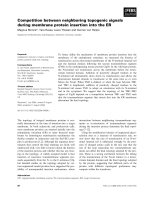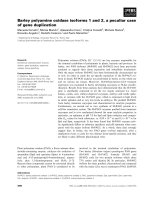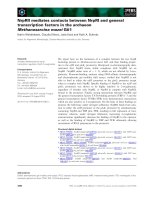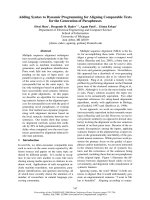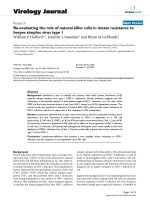Báo cáo khoa học: " Herpes simplex virus type 1 and normal protein permeability in the lungs of critically ill patients: a case of low pathogenicity" docx
Bạn đang xem bản rút gọn của tài liệu. Xem và tải ngay bản đầy đủ của tài liệu tại đây (56.2 KB, 6 trang )
Available online />Research
Herpes simplex virus type 1 and normal protein permeability in
the lungs of critically ill patients: a case of low pathogenicity?
Joanne Verheij
1
, AB Johan Groeneveld
2
, Albertus Beishuizen
3
, Arthur van Lingen
4
,
Alberdina M Simoons-Smit
5
and Rob JM Strack van Schijndel
6
1
Research Fellow, Departments of Intensive Care and Nuclear Medicine, and the Institute for Cardiovascular Research, VU University Medical Center,
Amsterdam, The Netherlands
2
Associate Professor, Department of Intensive Care and the Institute for Cardiovascular Research, VU University Medical Center, Amsterdam, The
Netherlands
3
Assistant Professor, Department of Intensive Care, VU University Medical Center, Amsterdam, The Netherlands
4
Associate Professor, Department of Nuclear Medicine, VU University Medical Center, Amsterdam, The Netherlands
5
Associate Professor, Department of Medical Microbiology and Infection Control, VU University Medical Center, Amsterdam, The Netherlands
6
Associate Professor, Department of Intensive Care, VU University Medical Center, Amsterdam, The Netherlands
Corresponding author: AB Johan Groeneveld,
Introduction
In some critically ill patients herpes simplex virus (HSV)-1 is
isolated from the upper or lower respiratory tract [1–15].
Immunodepressed patients may be susceptible to trans-
mission and acquisition of viral diseases; alternatively, viral
reactivation may occur and may contribute relatively little to
morbidity and mortality. Indeed, reactivation of human
herpesvirus-6 is common in critically ill patients and does not
worsen outcome [16,17]. In immunocompetent patients,
however, isolation of HSV-1 may be associated with viral
pneumonia, even if reactivation rather than primary infection is
responsible [6,8,18]. HSV-1 has been associated with acute
R139
ALI = acute lung injury; ARDS = acute respiratory distress syndrome; CPM = counts per minute; HSV = herpes simplex virus; LIS = lung injury
score; PLI = pulmonary leak index; RBC = red blood cell.
Abstract
Introduction We conducted the present study to evaluate the pathogenicity of late respiratory
infections with herpes simplex virus (HSV)-1 in critically ill patients.
Methods The study was conducted in four critically ill patients with persistent pulmonary infiltrates of
unknown origin and in whom HSV-1 was isolated from tracheal aspirate or bronchoalveolar lavage
fluid. At a median of 7 days (range 1–11 days) after mechanical ventilatory support had been initiated,
the pulmonary leak index for gallium-67-labelled transferrin (upper limit of normal 14.1 × 10
–3
/min) was
determined.
Results The pulmonary leak index ranged between 7.5 and 14.0 × 10
–3
/min in the patients studied.
Two of the four patients were administered a course of aciclovir, and all four patients survived.
Conclusion The normal capillary permeability observed in the lungs suggests that that HSV-1 is not
pathogenic in the critically ill. Our findings suggest that isolation of the virus represents reactivation
during the course of serious illness, and that immunodepression is responsible rather than relatively
harmless primary or superimposed infection in the lungs.
Keywords capillary permeability, critical illness, pathogenicity, pulmonary leak index, viral pneumonia
Received: 5 November 2003
Revisions requested: 28 January 2004
Revisions received: 3 February 2004
Accepted: 12 March 2004
Published: 31 March 2004
Critical Care 2004, 8:R139-R144 (DOI 10.1186/cc2850)
This article is online at />© 2004 Verheij et al., licensee BioMed Central Ltd. This is an Open
Access article: verbatim copying and redistribution of this article are
permitted in all media for any purpose, provided this notice is
preserved along with the article's original URL.
Open Access
R140
Critical Care June 2004 Vol 8 No 3 Verheij et al.
respiratory distress syndrome (ARDS) and ventilator-associated
pneumonia in the critically ill [1–14], as either a primary or a
superimposed infection. However, there are few reports of
the virus eliciting an infectious host response, as demon-
strated by a rise in serum antibodies, by bronchoscopic
airway disease, by ‘typical’ findings on computed tomography
of the lungs, or by the presence of giant cells or nuclear
inclusion bodies on cytology or biopsy of the lower respiratory
tract [3,5,9,10,18]. Indeed, Tuxen and coworkers [4] observed
that prophylactic antiviral therapy in ARDS prevented
respiratory HSV-1 emergence but it had no impact on
duration of mechanical ventilation or on patient outcome. The
pathogenicity of the virus therefore remains unknown, and the
rare association in the critically ill of HSV-1 isolation with
mortality may represent reactivation of the virus in
immunodepressed patients with multiple organ failure and
poor outcome [1,2,11,14,15], rather than a symptomatic
primary infection or superinfection contributing to death.
Assessing pulmonary capillary protein permeability non-
invasively at the bedside to yield the pulmonary leak index
(PLI) could help in determining the extent of tissue injury, as
was previously described [18–20]. This radionuclide
technique involves gallium-67-labelled transferrin (
67
Ga-
transferrin) and technetium-99m-labelled red blood cells
(
99m
Tc-RBCs). In bacterial pneumonia, for instance, the PLI is
elevated and the increase above normal directly relates to the
severity of pneumonia, expressed as the lung injury score
(LIS) [19]. In patients with acute lung injury (ALI) or ARDS
during the course of bacterial pneumonia, the PLI is uniformly
and greatly elevated above normal (up to 14.1 × 10
–3
/min)
when LIS is greater than 2.5; the PLI is also elevated in 80%
of patients with mild injury and a LIS between 1.5 and 2.5
[19]. Hence, the technique is a direct measure of permeability
and an indirect measure of capillary injury in the lungs. The
PLI is also elevated in interstitial lung disease [21].
In order to help differentiate between symptomatic and
asymptomatic viral shedding and spread, which could inform
the decision regarding whether to institute antiviral therapy
and help in determining the pathogenicity of the virus, we
measured the PLI in four consecutive critically ill patients with
persistent pulmonary infiltrates of unknown origin on
ventilatory support, in whom a HSV-1 had been isolated.
Methods
Patients and measurements
We studied a small series of consecutive patients in whom
respiratory secretions, sent for viral culture because of
persistent pulmonary infiltrates of unknown origin, were found
to be positive for HSV-1 (Table 1). Tracheal aspirates or
bronchoalveolar lavage fluid were transported directly to the
microbiology laboratory or placed in viral transport medium
(Copan Diagnostics Inc., Corona, CA, USA). For isolation of
HSV-1, specimens were inoculated using standard procedures
in triplicate flat bottom tubes on human embryonal lung
fibroblasts and incubated at 37°C. Cultures were studied
three times weekly for 10 days to identify the presence of a
cytopathic effect. If a cytopathic effect, indicating the
presence of HSV-1, was apparent or otherwise at days 2 and
7, the cells were fixed in methanol:acetone (1:1) and typed
by immunofluorescence with labelled specific HSV-1 and
HSV-2 antibodies (Syva Mikrotac HSV-1/HSV-2 typing kit,
Palo Alto, CA, USA). In the four patients studied, the results
were available within 3 days after samples had been
inoculated in culture medium.
On the day of specimen collection for viral culture,
demographic, chest radiographic and respiratory data were
recorded, as were clinical features. In three out of four
patients on mechanical ventilation after intubation, the total
respiratory compliance was calculated from ventilator settings
as follows (ml/cmH
2
O): tidal volume/(plateau – end-expiratory
pressure). From the radiographic score (ranging from 0 to 4
depending on the number of quadrants with radiographic
opacities), the ratio of arterial oxygen tension to fractional
inspired oxygen, the level of positive end-expiratory pressure
and the compliance, the LIS was calculated [22]. (LIS ranges
between 0 and 4, with values up to 2.5 denoting ALI and
those above 2.5 ARDS.) None of the patients had visible
oropharyngeal vesicles.
Radionuclide method
To characterize further the persistent pulmonary infiltrates,
the PLI was measured using a modification to a method
described previously [19,20]. Because this is a routine
procedure, informed consent was waived. Autologous RBCs
were labeled with
99m
Tc (11 MBq, physical half-life 6 hours;
Mallincrodt Diagnostica, Petten, The Netherlands), using a
modified in vitro method. Ten minutes after injection of the
labelled RBCs, transferrin was labelled in vivo, following
intravenous injection of
67
Ga-citrate (6 MBq, physical half-life
78 hours; Mallincrodt Diagnostica). Patients were in the
supine position, and two scintillation detection probes were
positioned over the right and left lung apices. The probe
system (manufactured by Eurorad C.T.T., Strasbourg, France)
consists of two small cesium iodide scintillators
(15×15×15mm
3
), each in a 2-mm tungsten and 1-mm
aluminium housing cover (35 mm in diameter and 40 mm in
height). The front end of each probe has an aluminium flange
attached (3 mm in thickness and 70 mm in diameter) to
facilitate easy fixation to the patient’s chest with tape. Each
probe weighs approximately 255 g. The probe signals are led
into a dual amplifier, from which the output is fed into a multi-
channel analyzer system connected to a personal computer.
Because the probes have separate channels, there is no
electronic crossover.
Starting at the time of the intravenous injection of
67
Ga,
radioactivity was measured each minute for 1 hour. For each
measurement interval, the entire spectrum of photon energies
was stored on disk. During processing, the
99m
Tc and
67
Ga
R141
Available online />Table 1
Clinical characteristics of study patients and ventilatory parameters
Patient (date)
Characteristic/parameter 1 (September 2001) 2 (November 2001) 3 (November 2001) 4 (February 2002)
General parameters
Age 45 19 84 78
Sex Female Male Female Male
Underlying disease – Nasopharyngeal carcinoma Hypertension Heart failure
Reason of admission Pneumonia of Septic shock; Aspiration pneumonia; Mycoplasma pneumoniae
unknown origin; ALI/respiratory failure respiratory failure pneumonia
respiratory failure and shock
Comorbidity – Heart failure Heart failure Prior coronary
artery surgery
Prior chemotherapy/radiotherapy No Yes No No
Duration of mechanical ventilation 13 5 10 1
before isolation (days)
Duration mechanical ventilation after 8 1 11 6
isolation (days)
Length of stay in ICU (days) 26 8 21 42
Infectious parameters
Duration between sampling and 5 1 1 1
reporting of positive cultures (days)
Respiratory source of HSV-1 BAL TA TA TA
Other sources of HSV-1 Throat, skin Throat – –
Leucocytes in Gram stain of Few lymphocytes Few Moderate Few
BAL/TA fluids
Bacteria in culture Streptococcus aureus ++, Candida albicans ++ Multiresistant No micro-organisms
Candida albicans ++ Pseudomonas aeruginosa,
Escherichia coli
Serology High IgG titre
Body temperature (°C) 37.4 36.2 37.2 38.2
Blood leucocytes (×10
9
/l) 16.2 4.5 9.5 16.4
Antiviral therapy Aciclovir – Aciclovir –
Treatment with steroids Prednisone
Respiratory parameters
Pa
O
2
/FiO
2
(mmHg) 345 195 190 98
Plateau airway pressure (cmH
2
O) 33 22 22 20
Positive end-expiratory airway 12 7 7 5
pressure (cmH
2
O)
Total respiratory compliance (ml/cmH
2
O) 21 31 31 –
Radiographic score 4 4 3 4
LIS 2.5 2.5 2.2 2.3
Central venous pressure (mmHg) 10 8 – –
PLI (×10
–3
/min) 10.5 7.5 8.0 14.0
Duration between sampling and PLI (days) 0 0 1 2
The measurements were taken at the time of herpes simplex (HSV)-1 isolation from tracheal aspirate (TA) or bronchoalveolar lavage (BAL). FiO
2
,
fractional inspired oxygen; ICU, intensive care unit; LIS, lung injury score; PaO
2
, arterial oxygen tension; PLI, pulmonary leak index.
R142
count rates were corrected for background radioactivity,
physical half-life, spill-over of
67
Ga into the
99m
Tc window,
obtained by in vitro measurement of
67
Ga, and expressed as
counts per minute (CPM) per lung field. At 5, 8, 11, 15, 20,
25, 30, 40, 50 and 60 min after
67
Ga injection, blood
samples (2 ml) were drawn from the cannula in the radial or
femoral artery. Each blood sample was weighed and
radioactivity of 1 ml blood was measured in duplicate for
each blood sample. Radioactivity measurements in these
samples were done with a single-well well counter (LKB
Wallac 1480 WIZARD, Perkin Elmer Life Science, Zaventem,
Belgium). The software automatically corrects for
background, spillover of
67
Ga into
99m
Tc, and decay. Results
were expressed as CPM/g. For each blood sample, a time-
matched CPM over each lung was measured. A radioactivity
ratio was calculated – (
67
Ga
lung
/
99m
Tc
lung
)/(
67
Ga
blood
/
99m
Tc
blood
)
– and plotted against time. The PLI was calculated, using
linear regression analysis, from the slope of increase of the
radioactivity ratio divided by the intercept, in order to correct
for physical factors in radioactivity detection.
By taking pulmonary blood volume and thus presumably
surface area into account, the radioactivity ratio represents
the ratio of extravascular to intravascular
67
Ga radioactivity.
The PLI represents the transport rate of
67
Ga-transferrin from
the intravascular to the extravascular spaces in the lungs, and
it is therefore a measure of pulmonary capillary permeability to
transferrin [19,20]. The mean PLI from the two lungs was
taken. The upper limit of normal PLI is 14.1 × 10
–3
/min. Where
appropriate, numbers are summarized as median (range).
Results
Patient data are presented in Table 1. The patients had
stayed for some time in the hospital or intensive care unit
before HSV-1 was isolated, and they had been admitted
primarily because of respiratory insufficiency during the
course of pneumonia. Patient 4 was admitted into the
coronary care unit a few days before intensive care unit
admission for cardiogenic pulmonary oedema. All patients
had been dependent on mechanical ventilatory support for
some time before sampling. They had received adequate
antibiotic therapy for pneumonia and had ALI at the time of
sampling, which was of otherwise unknown origin.
Table 1 shows that patients had radiographic abnormalities
but without an increased PLI. Central venous pressure was
not elevated, which suggests that the persistent pulmonary
infiltrates were not caused by overhydration. In patients 1 and
3 a high-resolution computed tomography scan of the lungs
with contrast was obtained; the findings were nonspecific,
however, with alveolar consolidations and pleural fluid, even
in the presence of interstitial abnormalities with a ground
glass appearance in patient 3. In patient 1 a bronchoscopy
was performed and there were no mucosal lesions. There
was a normal distribution of lymphocyte subtypes in the
lavage fluid. A transbronchial biopsy revealed interstitial
inflammation with many macrophage deposits, and immuno-
histochemical staining for HSV-1 was negative. No multi-
nucleated cells or cell inclusions were observed, either in
bronchoalveolar lavage fluid from patient 1 or in tracheal
aspirates from the other patients. In patients 1–3 concomitant
isolation of bacteria by culture was regarded as bacterial
colonization. Antibody testing was not done in patients 2–4
but was found to be positive for anti-HSV-1 IgG in patient 1,
which is indicative of prior HSV-1 infection.
The antiviral agent aciclovir (10 mg/kg three times daily) was
started when cultures became positive in two patients, at the
discretion of the treating physician. Aciclovir was withheld in
the other two patients because it was presumed that the
pulmonary infiltrates were not caused by HSV-1, on the basis
of a normal PLI among other findings. In patient 1, who had a
normal PLI, a course of steroids was initiated on the day after
the PLI was measured, and was continued despite positivity
for HSV-1, reported 5 days later. All patients survived until
discharge from the intensive care unit.
Discussion
The
67
Ga-transferrin PLI is a sensitive and specific measure
of pulmonary capillary permeability, which is utilized for non-
invasive assessment of severity of a broad range of
pulmonary conditions [19–21]. The PLI roughly parallels
clinical severity (i.e. the LIS) [19,20]. Although it involves the
use of relatively routine equipment, the diagnostic method
has not gained broad application, partly because of its
laborious nature [20]. It has the advantage that bedside
measurements are possible in mechanically ventilated
critically ill patients, who cannot easily be transported.
Pulmonary inflammation, of whatever cause, increases the PLI
up to four times normal values in the most severe forms of
lung injury, including ARDS. In less severe injury, such as
impending ARDS and interstitial lung disease, the PLI is also
elevated, albeit to a lesser extent, as reported by us and other
groups [20,21].
The patients had in common a prior infectious episode,
followed by a relatively prolonged period of respiratory
insufficiency. They had persistent and nonspecific pulmonary
infiltrates of unknown origin, after treatment of their primary
disease, which prompted viral culture. The normal PLI
observed suggests the involvement of a relatively harmless
reactivation of HSV-1, rather than the presence of a primary
and damaging infection. Indeed, critically ill patients with
sepsis may have late immunodepression, with lymphocytic
apoptosis, lymphocytopenia and T-cell anergy, promoting viral
reactivation [23,24]. Apparently, the virus must have been
latent in the nerve endings of the mucous membranes of the
upper respiratory tract in these patients [2,15]. Herpesviruses
(HSV-1) have frequently been isolated in vivo from respiratory
secretions of patients with ARDS [3,4] and detected in
surveillance cultures from the respiratory tract of patients
following burns, trauma, transplantation, major surgery and
Critical Care June 2004 Vol 8 No 3 Verheij et al.
R143
others. However, these viruses are detected in only 3% of
lung biopsies from patients with prolonged and unresolving
ARDS [3,7,9–13,15]. The literature is thus widely divergent
on the precise role of the virus in pulmonary disease in the
critically ill and its contribution to patient morbidity and
mortality [1–15].
We believe that the tracheal aspirates were representative of
lower respiratory tract secretions, in the absence of herpes
orolabialis and oral epithelial cells in smears for Gram stain of
the secretions. Concurrent colonization with other pathogens
has previously been described [5,13]. Because there was no
overlap in the duration of stay of the patients, transmission of
the virus from one patient to another can be excluded. This
further suggests that respiratory HSV-1 infections in the
critically ill may result from relatively harmless endogenous
reactivation. Although the normal PLI argues against pulmonary
parenchymal pathogenicity, tracheobronchitis caused by the
virus [18,25] cannot be ruled out, even in the absence of
orolabial lesions, because bronchoscopy was not performed
in three of the four patients, even though it was unremarkable
in patient 1. The persistent pulmonary infiltrates in our
patients may thus relate to slow radiographic resolution of
prior bacterial or aspiration pneumonia, rather then super-
imposed infection. Moreover, computed tomographic images
of the lung may be largely nonspecific [26], and so the
precise diagnostic criteria for HSV-1 pneumonia remain
unclear. When properly standardized, for instance with
respect to cell numbers in bronchoalveolar fluid or tracheal
aspirates, quantitative cultures, viral RNA and DNA by
polymerase chain reaction, could be helpful together with the
PLI in further studies to quantitate viral load and the ratio of
replication to shedding, and therefore the pathogenicity of the
virus in the lower respiratory tract.
In conclusion, the anecdotal data presented here suggest
that isolation of HSV-1 from respiratory secretions in the
critically ill patient with a persistent pulmonary infiltrate may
warrant evaluation of tissue injury potentially caused by the
virus to judge its pathogenicity. This could be done using a
radionuclide PLI measurement, and would help to inform
decisions regarding antiviral therapy, which may have adverse
effects. In some patients a normal PLI may argue against viral
pathogenicity, and withholding of aciclovir in such patients
may be safe.
Competing interests
None declared.
Acknowledgements
Thre authors’ contributions were as follows: Joanne Verheij and Arthur
van Lingen performed the PLI studies; Alberdina M Simoons-Smit per-
formed viral studies; and AB Johan Groeneveld, Albertus Beishuizen
and Rob JM Strack van Schijndel were responsible for intellectual
content and writing.
References.
1. Tuxen DV, Cade JF, McDonald MI, Buchanan MRC, Clark RJ, Pain
MCF: Herpes simplex virus from the lower respiratory tract in
adult respiratory distress syndrome. Am Rev Respir Dis 1982,
126:416-419.
2. Porteous C, Bradley A, Hamilton DNH, Ledingham IM, Clements
GB, Robinson CG: Herpes simplex virus reactivation in surgi-
cal patients. Crit Care Med 1984, 12:626-628.
3. Lheureux P, Verhest A, Vincent JL, Lienard C, Levivier M, Kahn RJ:
Herpes virus infection, an unusual source of adult respiratory
distress syndrome. Eur J Respir Dis 1985, 66:72-77.
4. Tuxen DV, Wilson JW, Cade JF: Prevention of lower respiratory
herpes simplex virus infection with acyclovir in patients with
the adult respiratory distress syndrome. Am Rev Respir Dis
1987, 136:402-405.
5. Prellner T, Flamholc L, Haidl S, Lindholm K. Widell A: Herpes
simplex virus: the most frequently isolated pathogen in the
lungs of patients with severe respiratory distress. Scand J
Infect Dis 1992, 24:283-292.
6. Schuller D, Spessert C, Fraser VJ, Goodenberger DM: Herpes
simplex virus from respiratory tract secretions: epidemiology,
clinical characteristics, and outcome in immunocompromised
and nonimmunocompromised hosts. Am J Med 1993, 94:29-
33.
7. Klainer AS, Oud L, Randazzo J, Freiheiter J, Bisaccia E, Gerhard
H: Herpes simplex virus involvement of the lower respiratory
tract following surgery. Chest 1994, Suppl:8S-14S.
8. Schuller D: Lower respiratory tract reactivation of herpes
simplex virus. Comparison of immunocompromised and
immunocompetent hosts. Chest 1994, Suppl:3S-7S.
9. Camazine B, Antkowiak JG, Enriqueta M, Lipman BJ, Takita H:
Herpes simplex viral pneumonia in the postthoracotomy
patient. Chest 1995, 108:876-879.
10. Byers RJ, Hasleton PS, Quigley A, Dennett C, Klapper PE, Cleator
GM, Faragher EB: Pulmonary herpes simplex in burns
patients. Eur Respir J 1996, 9:2313-2317.
11. Cook CH, Yenchar JK, Kraner TO, Davies EA, Ferguson RM:
Occult herpes family viruses may increase mortality in criti-
cally ill surgical patients. Am J Surg 1998, 176:357-360.
12. Papazian L, Thomas P, Bregeon F, Garbe L, Zandotti C, Saux P,
Gaillat F, Drancourt M, Auffray JP, Gouin F: Open-lung biopsy in
patients with acute respiratory distress syndrome. Anesthesi-
ology 1998, 88:935-944.
13. Cherr GS, Meredith JW, Chang M: Herpes simplex virus pneu-
monia in trauma patients. J Trauma 2000, 49:547-549.
14. Van den Brink J-W, Simoons-Smit AM, Beishuizen A, Girbes ARJ,
Strack van Schijndel RJM, Groeneveld ABJ: Respiratory herpes
simplex virus type 1 infection/colonisation in the critically ill:
marker or mediator ? J Clin Virol 2004, 30:68-72.
15. Bruynseels P, Jorens PG, Demey HE, Goossens H, Pattyn SR,
Elseviers MM, Weyler J, Bossaert LL, Mentens Y, Ieven M:
Herpes simplex virus in the respiraotry tract of critical care
pateitns: a prospective study. Lancet 2003, 362:1536-1541.
16. Desachy A, Ranger-Rogez S, François B, Venot C, Traccard I,
Gastinne H, Denis F, Vignon P: Reactivation of human her-
pesvirus type 6 in multiple organ failure syndrome. Clin Infect
Dis 2001, 32:197-203.
Available online />Key messages
• With help of gallium-67-transferrin and technitium-
ggm-red blood cells, a pulmonary leak index can be
measured as an index of capillary permeability and lung
injury. In 7 patients with HSV-1 from tracheal aspirate
or bronchoalveloar fluid, the index was normal,
suggesting low pathogenicity of the virus
• Low pulmonary pathogenicity of HSV-1 in the
respiratory tracts argues for relatively harmless
reactivation following immunodepression
• When pulmonary pathogenicity is low, antiviral therapy
may be safely withheld
R144
17. Razonable RR, Fanning C, Brown RA, Espy MJ, Rivero A, WIlson
J, Kremers W, Smith TF, Paya CV: Selective reactivation of
human herpesvirus 6 variant A occurs in critically ill immuno-
competent hosts. J Infect Dis 2002, 185:110-113.
18. Ramsey PG, Fife KH, Hackman RC, Meyers JD, Corey L: Herpes
simplex virus pneumonia. Ann Intern Med 1982, 97:813-820.
19. Groeneveld AB, Raijmakers PG: The
67
Gallium-transferrin pul-
monary leak index in pneumonia and associated adult respi-
ratory distress syndrome. Clin Sci 1997, 93:463-470.
20. Groeneveld AB: Radionuclide assessment of pulmonary
microvascular permeability. Eur J Nucl Med 1997, 24:449-461.
21. Ishizaka A, Hasegawa N, Nakamura K, Takagi Y, Takano M, Yam-
aguchi K, Kubo A: Usefulness of pulmonary vascular leakiness
assessment in interstitial pneumonitis. Chest 2001, 119:1455-
1460.
22. Murray JF, Mattay MA, Luce JM, Flick MR: Pulmonary perspec-
tives, an expanded definition of the adult respiratory distress
syndrome. Am Rev Respir Dis 1988, 138:720-723.
23. Nash AA: T cells and the regulation of herpes simplex virus
latency and reactivation. J Exp Med 2000, 191:1455-1457.
24. Oberholzer A, Oberholzer C, Moldawer LL: Sepsis syndrome:
understanding the role of innate and acquired immunity.
Shock 2001, 16:83-96.
25. Sherry MK, Klainer AS, Wolff M, Gerhard H: Herpetic tracheo-
bronchitis. Ann Intern Med 1988, 109:229-233.
26. Aquino SL, Dunagan DP, Chiles C, Haponik EF: Herpes simplex
virus 1 pneumonia: patterns on CT scans and conventional
chest radiographs. J Comput Assist Tomogr 1998, 22:795-800.
Critical Care June 2004 Vol 8 No 3 Verheij et al.
